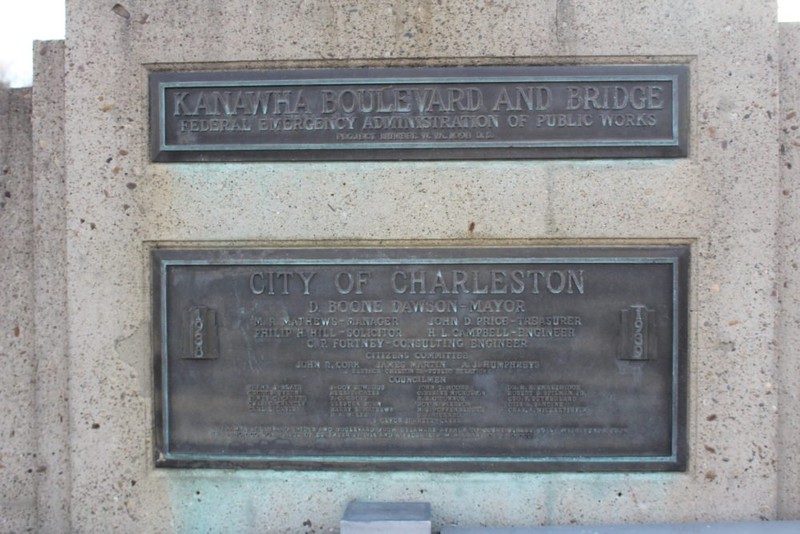Elk River Girder Span Bridge
Introduction
Text-to-speech Audio
The bridge spans the mouth of the Elk River at Kanawha Blvd. in Charleston, West Virginia. It was constructed in 1939 and is 500 feet long. At one end of the bridge, there are two plaques, one is original from 1938 and the other is from the bridge's restoration in 1985. The bridge was designed to link with the existing segment of Kanawha Boulevard (US 60 East) east of Charleston and help manage the growing commuter traffic as the region's population increased. The bridge was a product of President Franklin D. Roosevelt's New Deal initiatives which created jobs across the country during the Great Depression.
Images
Photo of the Kanawha Blvd. Bridge courtesy of Ernest Everett Blevins

The bridge while still under construction

1985 Restoration and Rededication Plaque Photo courtesy of Ernest Everett Blevins

Original New Deal Plaques Photo courtesy of Ernest Everett Blevins

Backstory and Context
Text-to-speech Audio
During the Great Depression, the city of Charleston wanted to construct a multi-lane road to help with the growing traffic problems that existed in the city at the time. In combination with President Franklin D. Roosevelt's New Deal and the Public Works Administration (PWA), the city received a grant of $450,000 in 1937 to build a new bridge.1 Bids on the bridge began to come from the PWA Chicago office in late 1937 and almost all property rights were secured by March of 1938. Construction began within a month and was completed later that year. The project's consulting engineer C.P. Fortney claimed the bridge was the longest continuous girder span in the world.2 A girder bridge is made of beams forming an I or Box section which support a deck slab, the portion which people walk and drive on. The Kanawha Blvd. bridge crosses the mouth of the Elk River and runs parallel to the Kanawha River. The bridge is still standing today, though it was restored and some parts rebuilt in 1985. This restoration is commemorated with a second plaque.
With democratic control of the West Virginia State Legislature and President Roosevelt and democratic Governor Herman Guy Kump in office in 1933, the New Deal found many strong supports in West Virginia. New Deal policies helped to bring in construction jobs across the state on projects to improve infrastructure by building bridges, roads, and public buildings. Other examples of lasting New Deal projects in the state include Huntington's flood control walls and Babcock State Park. In addition to construction and parks projects, the New Deal promoted unionization in the state and helped the United Mine Workers of America to form a union for West Virginia miners in 1933. Though the New Deal projects undoubtedly helped many survive the Great Depression, it was not a cure for West Virginia's economic troubles. The beginning of World War II and the increase in production across the country eliminated the need for New Deal projects and ended the programs.
With democratic control of the West Virginia State Legislature and President Roosevelt and democratic Governor Herman Guy Kump in office in 1933, the New Deal found many strong supports in West Virginia. New Deal policies helped to bring in construction jobs across the state on projects to improve infrastructure by building bridges, roads, and public buildings. Other examples of lasting New Deal projects in the state include Huntington's flood control walls and Babcock State Park. In addition to construction and parks projects, the New Deal promoted unionization in the state and helped the United Mine Workers of America to form a union for West Virginia miners in 1933. Though the New Deal projects undoubtedly helped many survive the Great Depression, it was not a cure for West Virginia's economic troubles. The beginning of World War II and the increase in production across the country eliminated the need for New Deal projects and ended the programs.
Sources
1 Peyton, Billy Joe. Historic Charleston: The First 225 Years. 73-74. San Antonio, TX: HPN Books, 2013.
New Deal. HISTORY. September 14, 2018. Accessed February 25, 2019. https://www.history.com/topics/great-depression/new-deal.
Girder Bridges. JFE Engineering Corporation. . Accessed February 25, 2019. http://www.jfe-eng.co.jp/en/products/infrastructure/bridge/br01.html.
Thomas, Jerry Bruce. New Deal. West Virginia Encyclopedia. October 12, 2010. Accessed February 25, 2019. https://www.wvencyclopedia.org/articles/2265.
McKee, Brent. Kanawhat Boulevard Bridge - Charleston, WV. Living New Deal. March 27, 2018. Accessed February 25, 2019. https://livingnewdeal.org/projects/kanawha-boulevard-bridge-charleston-wv/.
New Deal. HISTORY. September 14, 2018. Accessed February 25, 2019. https://www.history.com/topics/great-depression/new-deal.
Girder Bridges. JFE Engineering Corporation. . Accessed February 25, 2019. http://www.jfe-eng.co.jp/en/products/infrastructure/bridge/br01.html.
Thomas, Jerry Bruce. New Deal. West Virginia Encyclopedia. October 12, 2010. Accessed February 25, 2019. https://www.wvencyclopedia.org/articles/2265.
McKee, Brent. Kanawhat Boulevard Bridge - Charleston, WV. Living New Deal. March 27, 2018. Accessed February 25, 2019. https://livingnewdeal.org/projects/kanawha-boulevard-bridge-charleston-wv/.
